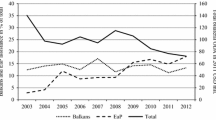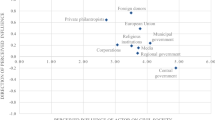Abstract
Earlier stock-taking work on civil service system development in Central and Eastern Europe (CEE) and the Commonwealth of independent States (CIS) (Verheijen, 1999) showed a move from a relative similarity of approach in the early 1990s, when all transition states struggled to overcome the legacy of politicized and discredited state administrations, to a much more divergent pattern that emerged from the start of the last decade. The three factors identified that determined the civil service development path taken were proximity to the EU (and likelihood of EU membership), vision on the role of the state and model of political governance.
Access this chapter
Tax calculation will be finalised at checkout
Purchases are for personal use only
Preview
Unable to display preview. Download preview PDF.
Similar content being viewed by others
Bibliography
Baker, R. (2002) Transitions from Authoritarianism: The Role of Bureaucracy (New York: Praeger).
Barro, R.J. (1991) ‘Economic Growth in a Cross-Section of Countries,’ Quarterly Journal of Economics, 106(2), 407–443.
Bekke, H.A.G.M., James L. Perry and Theo A.J. Toonen (eds) (1996) Civil Service Systems in a Comparative Perspective (Bloomington, IN: Indiana University Press).
Bhatti, Z.K., Z. Kusek and T. Verheijen (2014) Lessons from South Asia on How People and Government Can Connect (World Bank Publications).
Cardona, F. (2000) European Public Administration Principles. SIGMA Papers 27 (Paris: OECD).
Dimitrova, A. (2002) ‘Enlargement, Institution-Building and the EU’s Administrative Capacity Criteria,’ West European Politics, 25(4), 171–190.
Emrich-Bakenova, S. (2009) ‘Trajectory of Civil Service Development in Kazakhstan: Nexus of Politics and Administration,’ Governance: An International Journal of Policy, Administration and Institutions, 22(4), 717–745.
Fournier, J. (1998) ‘Governance and European Integration — Reliable Public Administration in OECD,’ in OECD (ed.) Preparing Public Administrations for the European Administrative Space. SIGMA Papers 23 (Paris: OECD).
Goetz, K.H. (2001) ‘Making Sense of Post-Communist Central Administration: Modernization, Europeanization or Latinization?’ Journal of European Public Policy, 5(6), 1032–1051.
Goetz, K.H. and H. Margetts (1999) ‘The Solitary Centre: The Core Executive in Central and Eastern Europe,’ Governance, 12(4), 425–453.
Iancu, D.C. and M. Ungureanu (2013) ‘Conditionality and Reform Reversal: The Case of the Romanian Civil Service.’ Draft paper presented at the NISPAcee conference in Belgrade, May.
Inkina, S. (2013) ‘Civil Service Reform in Transition: A Case Study of Russia,’ Review of European and Russian Affairs, 8(1), 1–12.
Kickert, W., T. Randma-Liiv and R. Savi (2013) Fiscal Consolidation in Europe: A Comparative Analysis. COCOPS Trend Report.
Knack, S. and P. Keefer (1995) ‘Institutions and Economic Performance: Crosscountry Tests Using Alternative Institutions Measures,’ Economics and Politics, 7(2), 207–227.
Konov A. n.d. Public Service and Administrative Reforms in Russia. Report by the Working Group on Public Sector Quality. http://unpan1.un.org/intradoc/groups/public/documents/NISPAcee/UNPAN025557.pdf (accessed October 2013).
Kotchegura, A. (2008). Civil Service Reform in Post-Communist Countries — The Case of the Russian Federation and the Czech Republic (Leiden: Leiden University Press).
Mauro, P. (1995) ‘Corruption and Economic Growth,’ Quarterly Journal of Economics, 110(3), 681–712.
Meyer-Sahling, J. (2009) Sustainability of Civil Service Reforms in Central and Eastern Europe Five Years After EU Accession. SIGMA Papers 44 (Paris: OECD Publishing).
Meyer-Sahling, J. (2012) Civil Service Professionalisation in the Western Balkans. SIGMA Papers 48 (Paris: OECD Publishing).
Painter, M. and B. Guy Peters (eds) (2010) Tradition and Public Administration (London: Palgrave Macmillan).
Peters, B.G., L. Vass and T. Verheijen (eds) (2005) Coalitions of the Unwilling? Politicians and Civil Servants in Coalition Governments (Bratislava: NISPAcee).
Pierre, J. and B.G. Peters (2003) Handbook of Public Administration (London: Sage).
Rabrenovic, A. and T. Verheijen (2005) ‘Politicians and Top Level Officials in Former Yugoslav States, Back to Discarded Traditions?’ in A. Rosenbaum and J. Nemec (eds) Democratic Governance in the Central and Eastern European Countries: Challenges for the XXI century (Bratislava: NISPAcee), pp. 133–150.
Rauch, James B. and Peter B. Evans (2000) ‘Bureaucratic Structure and Bureaucratic Performance in Less Developed Countries,’ Journal of Public Economics, 75, 49–71.
RCPAR (2010) Comparative Research in Challenges for Public Sector Human Resources Management in an Economic Downturn, (UNDP, Bratislava Regional Centre).
SIGMA (2012a) Assessment: Bosnia and Herzegovina, March 2012. http://www.oecd.org/site/sigma/publicationsdocuments/BiH_Assess_2012.pdf (accessed September 30, 2014).
SIGMA (2012b) Assessment, Serbia, 2012. http://www.oecd.org/site/sigma/publicationsdocuments/48970654.pdf (accessed September 30, 2014).
SIGMA (2012c) Assessment: Montenegro, March 2012. http://www.oecd.org/site/sigma/publicationsdocuments/Montenegro_Assess_2012.pdf (accessed September 30, 2014).
Staronova, K. (2013) Innovative Elements in Civil Service Reform of Slovakia: Road to Professionalization? Paper presented at the NISPAcee conference in Belgrade, May.
Verheijen, T. (ed.) (1999) Civil Service Systems in Central and Eastern Europe (Edward Elgar: Cheltenham).
Verheijen, T. (2000) Administrative Capacity Building for EU Membership, A Race against Time? WRR Working Paper 109 (The Hague: WRR).
Verheijen, T. (ed.) (2001) Politico-Administrative Relations, Who Rules? (Bratislava: NISPAcee).
Verheijen, T. (2002) ‘Les Critères Administratifs d’adhésion a l’Union Européenne: sont-ils voues au placard?’ Revue d’Etudes comparatives Est-Ouest, 3, 79–99.
Verheijen, T. (2003) ‘L’Administration publique en Europe Centrale et Orientale: apparition d’un Modèle Émergent sui generis ou avatar des différentes traditions Européennes,’ Revue Française d’Administration Publique, 105–106 (November), 95–108.
Verheijen, T. (2004) ‘Administrative Transformation and the Accession Agenda,’ Zeitschrift für Staats- und Europawissenschaften, 3, 373–389.
Verheijen, T. (2007) Administrative Capacity in the New EU Member States: The Limits of Innovation. World bank Working Papers 115 (Washington DC).
Verheijen, T. (2010) ‘The New Member States of the European Union: Constructed and Historical Traditions and Reform Trajectories,’ in M. Painter and B. Guy Peters (eds) Tradition and Public Administration (London: Palgrave Macmillan).
Verheijen, T. and D.L. Coombes (eds) (1998) Innovations in Public Management (Cheltenham: Edward Elgar).
World Bank (2002) Serbia and Montenegro — Public Expenditure and Institutional Review (Washington, DC: World Bank).
World Bank (2003a) Macedonia — Public Expenditure and Institutional Review (Washington, DC: World Bank).
World Bank (2003b) Croatia — Country Economic Memorandum (Washington, DC: World Bank).
World Bank (2003c) International Public Administration Reform: Implications for the Russian Federation (Washington, DC: World Bank).
World Bank (2004a) Serbia and Montenegro — Public Administration Development, Creating the Conditions for Effective Economic and Social Reform (Washington, DC: World Bank).
World Bank (2004b) Lithuania — Review of the Civil Service Wage System, Report (Washington, DC: World Bank).
World Bank (2004c) The Fiscal Cost of Reform, Russia Public Expenditure Review (Washington, DC: World Bank).
World Bank (2005a) Linking Administrative Reform to Economic Growth Patterns: Review of Methods and Findings. Discussion Paper (Washington, DC: World Bank).
World Bank (2005b) Kazakhstan: Reforming the Public Sector Wage System (Washington, DC: World Bank).
World Bank (2007) EU 8 Administrative Capacity in the New Member States: The Limits of Innovation? (Washington, DC: World Bank).
World Bank (2008) Synthesis Note Vol. 1, Republic of Tajikistan — Public Sector Pay Reform — Policy Note on Medium Term Pay Reform in Public Sector, Civil Service, Education, Health, Social Protection, Science, Culture and Sport. Public Expenditure Review (PER) (Washington, DC: World Bank).
World Bank (2011) Russia — Public Expenditure Review (Washington, DC: World Bank).
World Bank (2012) Public Sector Management Approach (Washington, DC: World Bank).
World Bank and DFID (2004) Serbian Civil Service: Assessment of Pay and Benefits System, Report (PricewaterhouseCoopers).
Editor information
Editors and Affiliations
Copyright information
© 2015 Tony J.G. Verheijen and Aleksandra Rabrenovic
About this chapter
Cite this chapter
Verheijen, T.J.G., Rabrenovic, A. (2015). Civil Service Development in Central and Eastern Europe and the CIS: A Perfect Storm?. In: van der Meer, F.M., Raadschelders, J.C.N., Toonen, T.A.J. (eds) Comparative Civil Service Systems in the 21st Century. Palgrave Macmillan, London. https://doi.org/10.1057/9781137491459_2
Download citation
DOI: https://doi.org/10.1057/9781137491459_2
Publisher Name: Palgrave Macmillan, London
Print ISBN: 978-1-137-32578-5
Online ISBN: 978-1-137-49145-9
eBook Packages: Palgrave Political Science CollectionPolitical Science and International Studies (R0)




